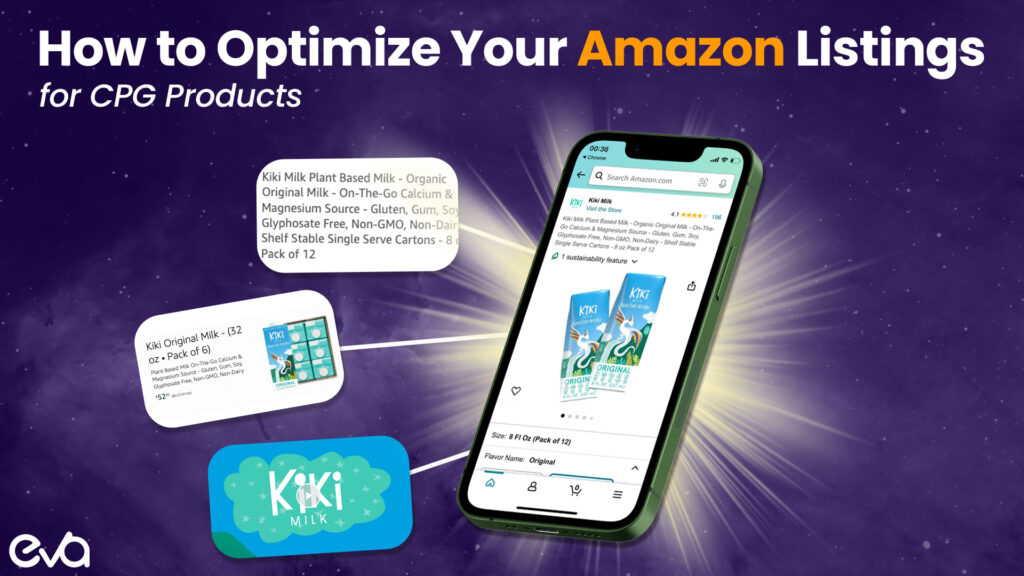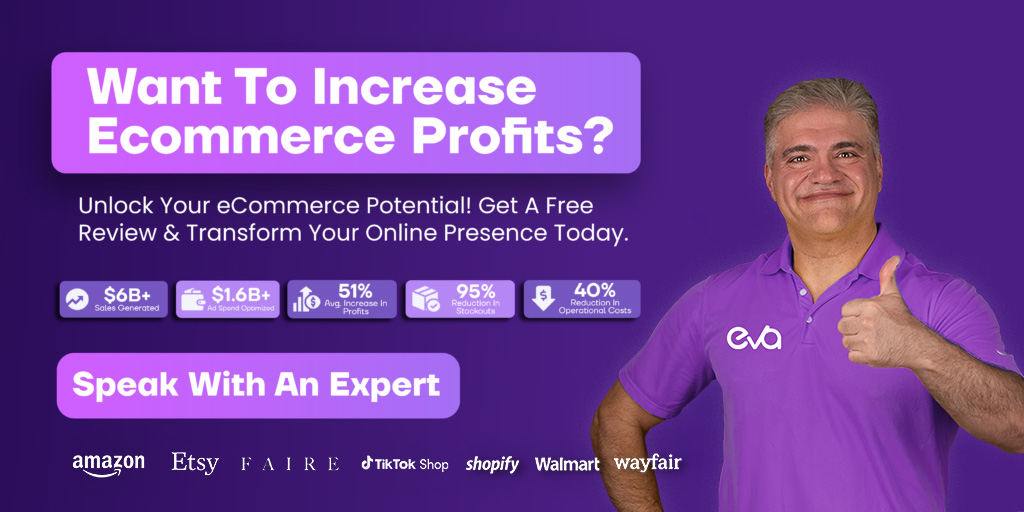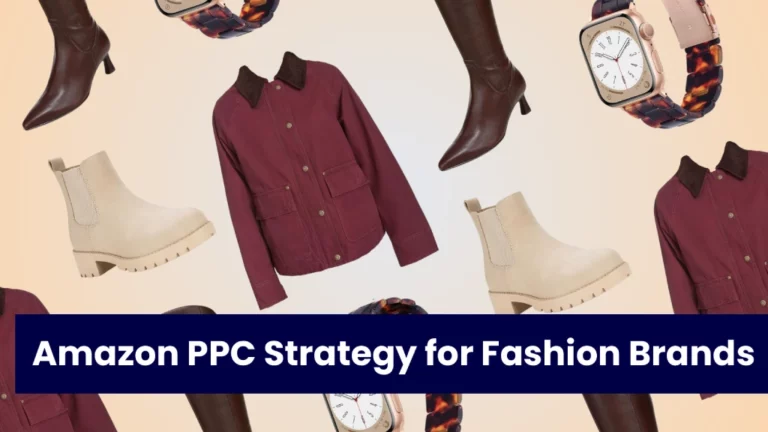Table of Contents
- Introduction
- What are CPG Products?
- Understanding Amazon’s Algorithm for CPG Listings
- Crafting High-Converting Amazon Titles for CPG Products
- Writing Compelling Bullet Points for CPG Listings
- Optimizing Amazon Product Descriptions for CPG
- Keyword Research and Optimization for CPG Listings
- Visual Optimization: Images and Videos for CPG Products
- Generating Positive Reviews for CPG Products
- Handling Seller Feedback vs. Product Reviews
- Leveraging Backend Search Terms for CPG Products
- How Eva Can Help You Optimize Amazon Listings for CPG Products
- Conclusion
- FAQs
Introduction
Amazon Consumer packaged goods (CPG products) are a key segment in e-commerce, encompassing a variety of everyday items. From personal care products to household essentials, these frequently purchased items represent a highly competitive market on platforms like Amazon. Success in this space depends on optimizing your Amazon listings to increase visibility and drive sales.
This guide will walk you through effective strategies to improve your Amazon listings for CPG products, ensuring they stand out and appeal to potential buyers.
What are CPG Products?
What is Amazon CPG Products?
Consumer Packaged Goods (CPG products) are items that consumers use regularly and need to replenish frequently. This category includes products such as food, beverages, toiletries, cleaning supplies, and over-the-counter medications.
Due to their frequent use and short shelf life, CPG products are central to e-commerce, particularly on Amazon, where they are in constant demand and often bought in bulk. The high demand creates opportunities, but it also means intense competition.
To succeed, your CPG products must be easily discoverable, attractively presented, and clearly differentiated from others.
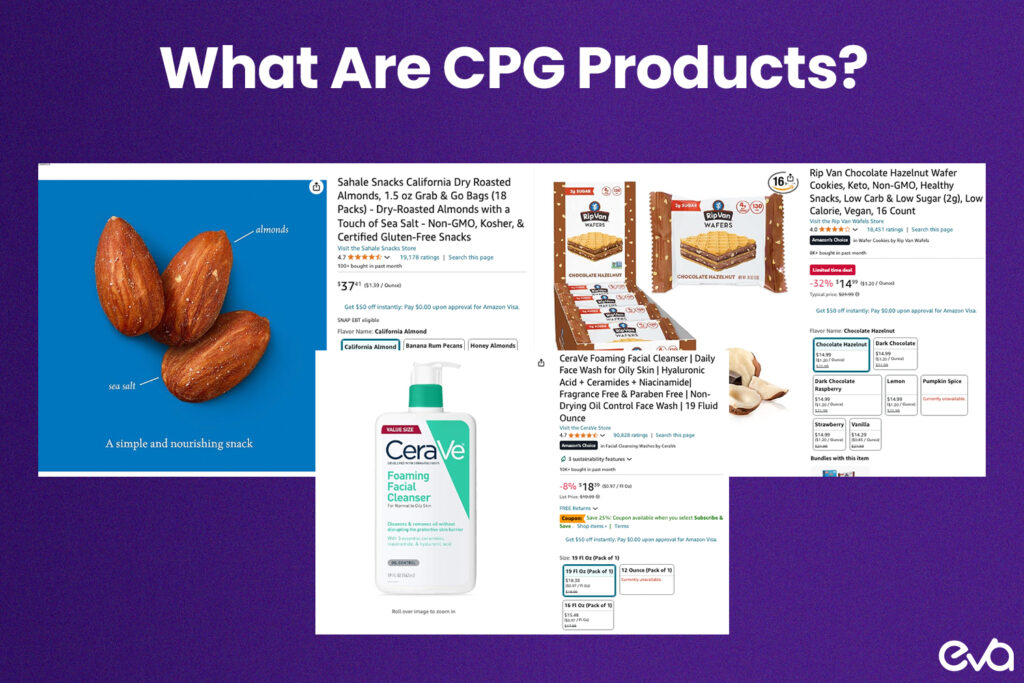
Why Optimizing Amazon Listings for CPG Products is Crucial for Success
Optimizing Amazon listings for CPG products is critical because it directly influences your product’s searchability and conversion rates.
In such a crowded market, a well-optimized listing can be the difference between a product that sells and one that doesn’t.
Key reasons why optimization is essential:
- Increased Visibility: Amazon’s marketplace is vast, filled with countless CPG products. Optimization helps ensure that your product appears in relevant searches, increasing its chances of being seen by potential buyers.
- Improved Conversion Rates: A well-crafted listing that highlights the product’s benefits, includes relevant keywords, and features clear, high-quality images can significantly boost conversion rates.
- Enhanced Customer Trust: Professional, detailed listings that include customer reviews, accurate descriptions, and compelling bullet points build trust with buyers, leading to repeat purchases.
Understanding Amazon’s Algorithm for CPG Listings
Amazon’s A10 algorithm is the engine behind its search engine, determining which products appear in search results and their order.
For CPG products, understanding this algorithm is key to gaining a competitive edge.
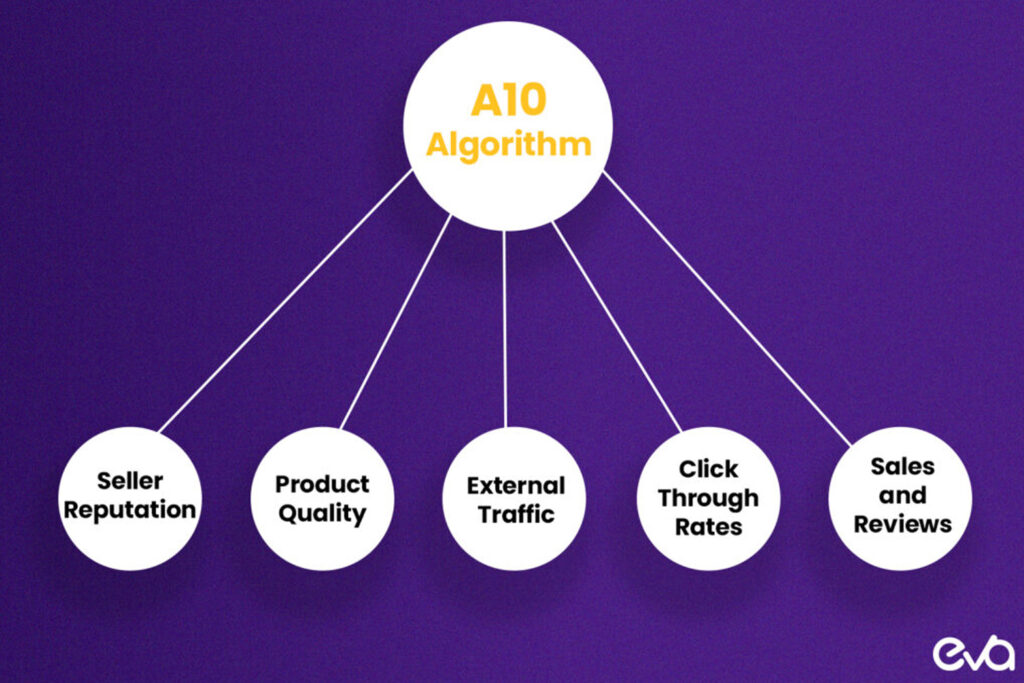
The A9 algorithm takes into account several factors:
- Relevance: How well your product listing matches the search query, including the presence of relevant keywords in your title, bullet points, and product description.
- Performance: This is measured by metrics like click-through rate (CTR), conversion rate, and sales history. High-performing products that consistently convert clicks into sales are favored by the algorithm.
- Customer Satisfaction: Positive reviews and low return rates signal to Amazon that customers are happy with your product, which can boost your ranking.
For CPG products, ensuring that your listings are optimized for these factors is crucial. The algorithm is designed to surface the most relevant and high-performing products, meaning that even small tweaks to your listings can have a significant impact.
Factors Influencing Product Visibility on Amazon
Several key factors influence product visibility on Amazon, particularly for CPG products:
- Keyword Relevance: Using the right keywords in your title, bullet points, and descriptions ensures that your product is seen by the right audience.
- Product Pricing: Competitive pricing can improve your chances of being featured in search results, especially in price-sensitive categories like CPG.
- Sales Velocity: The speed at which your products sell can affect your ranking. Consistent sales indicate to Amazon that your product is in demand.
- Customer Reviews and Ratings: Positive reviews not only build trust but also improve your product’s ranking. Encourage satisfied customers to leave reviews to boost your product’s visibility.
Table: Key Factors Influencing Amazon Product Visibility
| Factor | Description |
| Keyword Relevance | Ensuring your listing contains relevant keywords for search queries. |
| Product Pricing | Competitive pricing strategies can enhance visibility in search results. |
| Sales Velocity | Higher sales velocity indicates product demand, positively impacting ranking. |
| Customer Reviews | More positive reviews can boost both visibility and conversion rates. |
Importance of Relevance, Customer Satisfaction, and Conversion Rates
Relevance, customer satisfaction, and conversion rates are critical components of Amazon’s A9 algorithm. Here’s why each is vital:
- Relevance: If your listing isn’t relevant to the search query, it won’t appear in search results. This is why keyword optimization is crucial for CPG products.
- Customer Satisfaction: Satisfied customers leave positive reviews, which not only improve your product’s ranking but also build trust with new buyers.
- Conversion Rates: High conversion rates signal to Amazon that your listing effectively turns visitors into buyers. This can lead to higher rankings and more visibility.
Crafting High-Converting Amazon Titles for CPG Products
Amazon’s Title Guidelines for CPG Products
The product title is one of the first things shoppers see, and it plays a crucial role in both search visibility and conversions. Amazon has specific guidelines for creating effective product titles, especially for CPG products.
Key Guidelines:
- Length: Titles should be between 50-80 characters, including spaces. This length is optimal for mobile and desktop views.
- Capitalization Rules: Capitalize the first letter of each word, except for prepositions (like “in,” “on,” “at”) and conjunctions (like “and,” “or”).
- Numbers and Measurements: Use numerals (e.g., “10” instead of “ten”) and include measurements in a consistent format (e.g., “16 oz” instead of “sixteen ounces”).
- Details: Include critical product details like size, color, and quantity to help customers quickly identify the product they need.
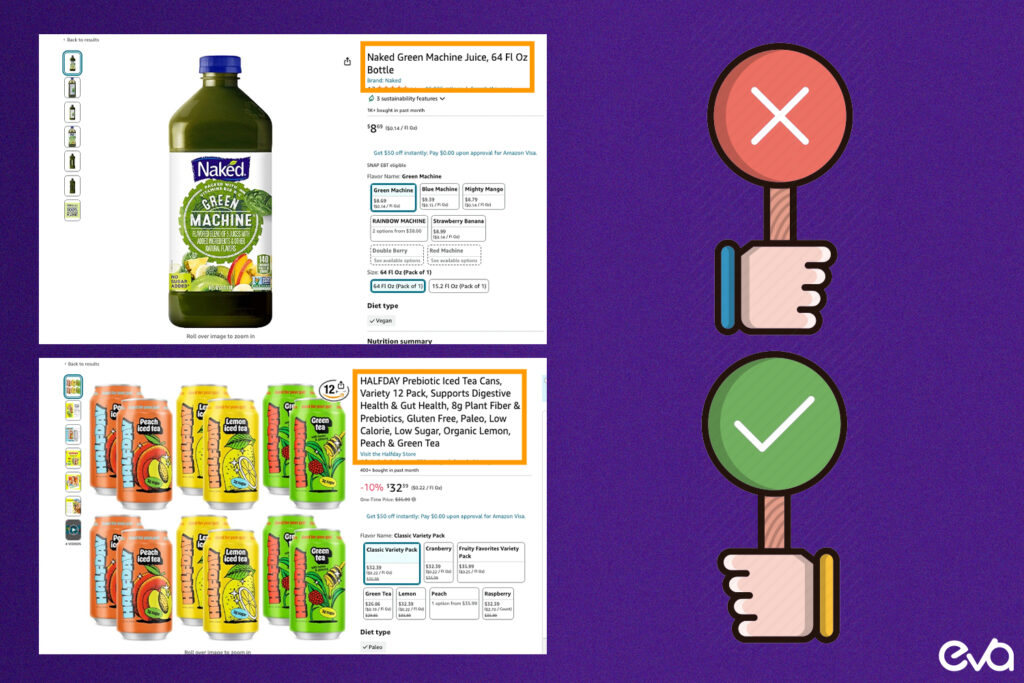
Tips for Creating Optimized Titles
Creating optimized titles requires balancing keyword inclusion with readability. Here’s how to do it effectively:
- Primary Keywords: Include your primary keyword as close to the beginning of the title as possible without making it awkward. Avoid keyword stuffing, as it can make the title unreadable and may result in penalties.
- Clear and Concise: Ensure that your title is easy to read and understand at a glance. Avoid using unnecessary words that don’t add value to the product description.
- Include Specifics: Details like size, color, and quantity can make your product stand out and meet customer needs more effectively.
Writing Compelling Bullet Points for CPG Listings
Why Bullet Points Matter in CPG Listings
Bullet points are critical in Amazon listings because they allow you to communicate essential product details quickly and effectively. For CPG products, where customers often compare similar items, clear and compelling bullet points can make the difference between a sale and a missed opportunity.
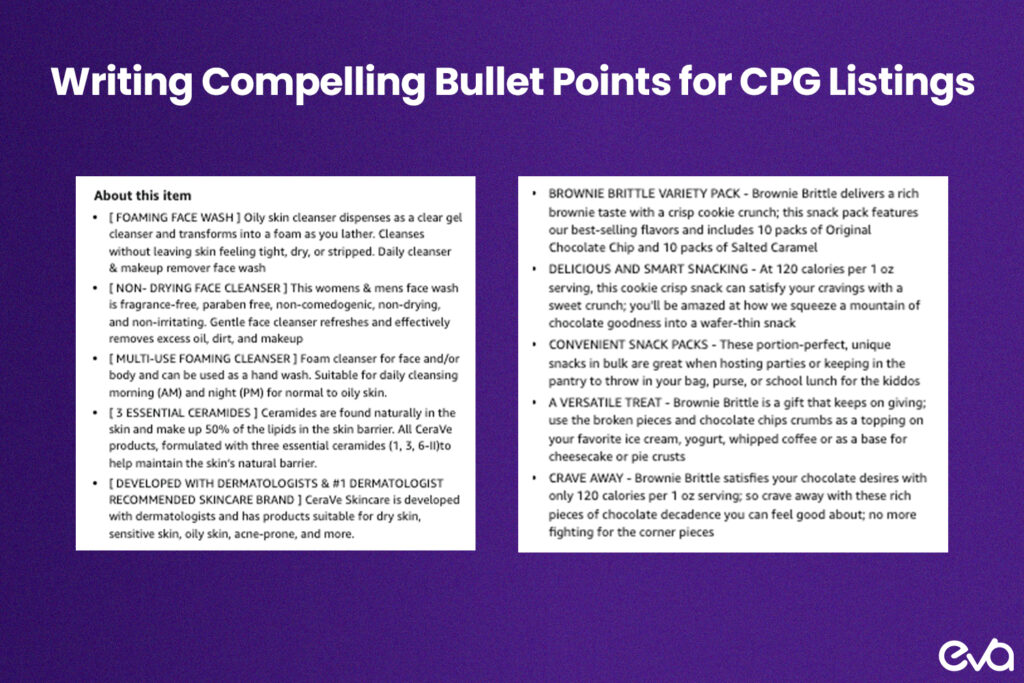
Benefits of Bullet Points:
- Highlight Features and Benefits: Bullet points are your opportunity to emphasize what makes your product unique. Focus on benefits first, then elaborate on features.
- Enhance Readability: Bullet points break down complex information into digestible chunks, making it easier for customers to understand the product quickly.
- Address Customer Pain Points: Use bullet points to address common customer concerns, such as “safe for sensitive skin” or “easy-to-use packaging.”
Best Practices for CPG Bullet Points
To craft effective bullet points for your CPG products, follow these best practices:
- Start with Key Benefits: Lead with the most compelling benefits of your product. For example, “Eliminates tough stains in one wash” before diving into the features.
- Include Detailed Features: After the benefits, provide detailed information about the product, such as “Contains 64 loads of detergent” or “Available in fresh lavender scent.”
- Address Common Concerns: If your product solves a common problem, make sure this is highlighted in your bullet points. For instance, “BPA-free packaging” or “Hypoallergenic formula.”
Example Bullet Points:
- Tough on Stains: Formulated to eliminate stubborn stains with just one wash.
- Long-Lasting Supply: Each 100 oz bottle delivers 64 loads, ensuring you won’t run out quickly.
- Safe for All Fabrics: Gentle enough for delicate clothing yet effective on heavy-duty fabrics.
- Eco-Friendly Packaging: Made from 100% recyclable materials, helping reduce your carbon footprint.
- Fresh Scent: Leaves clothes with a pleasant, long-lasting fragrance.
Optimizing Amazon Product Descriptions for CPG
The Importance of Product Descriptions
The product description is where you can expand on the details mentioned in your title and bullet points.
For CPG products, a well-crafted description can influence search rankings and customer purchasing decisions.
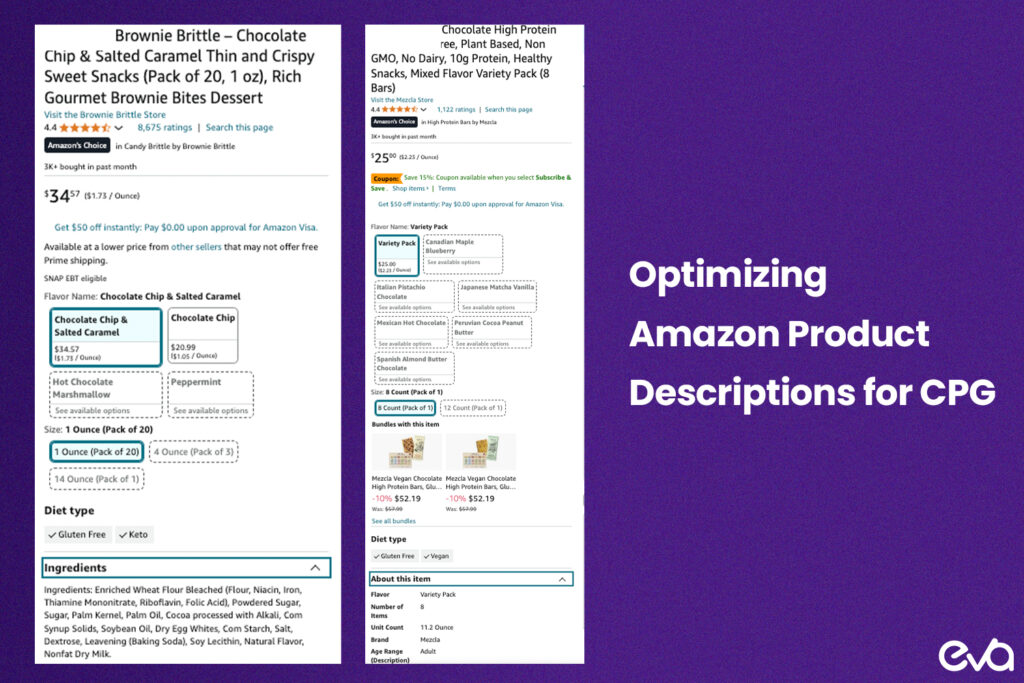
Why Descriptions Matter:
- Search Ranking: Descriptions contribute to your product’s search ranking by including secondary keywords and expanding on the primary keyword.
- Customer Decisions: A detailed and persuasive description helps customers better understand the product, leading to higher conversion rates.
- Highlighting Unique Selling Points (USPs): Use the description to emphasize what sets your product apart from competitors.
Crafting Detailed and Persuasive Descriptions
When writing a compelling product description, focus on the following elements:
- Descriptive Language: Use language that vividly describes the product’s benefits. For example, “This detergent not only removes stains but also brightens colors and leaves a fresh scent.”
- Unique Selling Points (USPs): Identify what differentiates your product from others. For example, “Our formula is hypoallergenic and safe for sensitive skin, making it ideal for families.”
- Natural Keyword Integration: Incorporate secondary keywords naturally throughout the description to boost SEO without making it seem forced or awkward.
Example Description:
“ABC Brand Laundry Detergent is your go-to solution for all your laundry needs. Our hypoallergenic formula is gentle on skin yet tough on stains, making it perfect for families with sensitive skin. Each 100 oz bottle delivers 64 powerful loads that not only clean your clothes but also brighten colors and leave a fresh, lasting scent.”
Our eco-friendly packaging ensures you’re doing your part for the environment with every purchase.”
Table: Effective vs. Ineffective Product Descriptions
| Effective Description | Ineffective Description |
| Descriptive: “Brightens colors, leaves a fresh scent, and is safe for sensitive skin.” | Generic: “Cleans clothes.” |
| Detailed: “Each bottle delivers 64 loads, offering long-lasting value.” | Vague: “Lasts a long time.” |
| Persuasive: “Eco-friendly packaging helps reduce your carbon footprint.” | Uninspiring: “Packaging is recyclable.” |
Keyword Research and Optimization for CPG Listings
Finding High-Performing Keywords for CPG Products
Keyword research forms the foundation of a successful Amazon listing. Identifying high-performing keywords ensures that your product appears in relevant searches, directly influencing visibility and sales.
Tools and Methods for Keyword Research:
- Amazon’s Search Bar: Start by typing in potential keywords related to your product to see what auto-suggestions Amazon provides. These are often terms that customers frequently search for.
- Keyword Tools: Use tools like Helium 10, Jungle Scout, or Ahrefs to find high-volume, low-competition keywords specific to CPG products.
- Competitor Analysis: Look at the keywords your competitors are ranking for by analyzing their listings. This can provide insights into what might work for your products.
Importance of Long-Tail Keywords in CPG Listings
Long-tail keywords are longer, more specific phrases that often have less competition but can be highly effective in driving targeted traffic.
For CPG products, using long-tail keywords can help you reach a more precise audience.
Examples of Long-Tail Keywords:
- “Organic baby laundry detergent” instead of just “laundry detergent.”
- “Hypoallergenic cleaning wipes for sensitive skin” instead of just “cleaning wipes.”
- “100% recyclable paper towel rolls” instead of just “paper towels.”
Benefits of Long-Tail Keywords:
- Higher Conversion Rates: Long-tail keywords often attract buyers who are further along in the purchasing process, leading to higher conversion rates.
- Reduced Competition: These keywords tend to have less competition, making it easier to rank higher in search results.
Table: Examples of Primary vs. Long-Tail Keywords
| Primary Keyword | Long-Tail Keyword |
| Laundry Detergent | Organic baby laundry detergent |
| Cleaning Wipes | Hypoallergenic cleaning wipes for sensitive skin |
| Paper Towels | 100% recyclable paper towel rolls |
Incorporating Keywords Throughout Your Listing
Once you’ve identified your target keywords, it’s essential to incorporate them strategically throughout your listing:
- Titles: Place primary keywords at the beginning of the title for maximum impact.
- Bullet Points: Use keywords naturally in bullet points, focusing on benefits and features.
- Descriptions: Weave secondary keywords into the product description to improve SEO without keyword stuffing.
- Backend Search Terms: Use your backend search terms to include additional relevant keywords that didn’t fit naturally into the listing.
Visual Optimization: Images and Videos for CPG Products
Amazon’s Image Requirements for CPG Listings
Visual content is critical in e-commerce, and Amazon has specific guidelines to ensure that product images meet the platform’s standards.
Essential Guidelines:
- Image Size: Images should be at least 1000 pixels in either width or height. This ensures that the zoom function works properly, allowing customers to see details up close.
- Format: JPEG is the preferred format, although PNG and TIFF are also acceptable.
- Quality: Images should be high-resolution, well-lit, and clearly showcase the product.
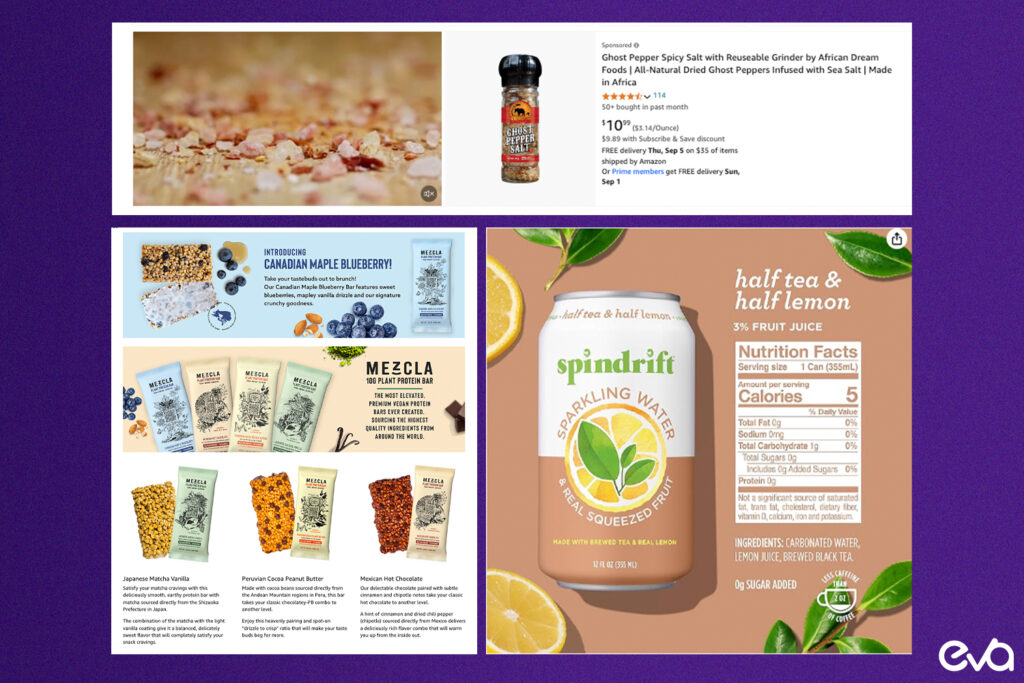
Best Practices for Using Product Images and Videos
To maximize the impact of your visual content, consider these best practices:
- Showcase Product Features: Use images to highlight key product features and benefits, such as packaging, size, and usage.
- Lifestyle Images: Include images that show the product in use, helping customers visualize how it fits into their daily lives.
- Product Videos: Create short, engaging videos that demonstrate the product in action. For example, a video showing how your cleaning wipes effectively remove stains can be more persuasive than a static image.
Example:
- Main Image: A clear, high-resolution image of the product.
- Feature Image: Close-up of the packaging, showing key information like size and ingredients.
- Usage Image: A lifestyle image showing the product in use, such as a family using your detergent in their laundry room.
- Video: A 30-second video demonstrating the effectiveness of the product in a real-life scenario.
Generating Positive Reviews for CPG Products
Importance of Reviews in Amazon’s Ecosystem
Customer reviews play a pivotal role in Amazon’s ecosystem. They not only influence potential buyers but also affect your product’s ranking on the platform.
Impact of Reviews:
- Trust: Positive reviews build trust and credibility, making new customers more likely to purchase.
- Ranking: Amazon’s algorithm favors products with higher ratings and more reviews, boosting their visibility in search results.
- Conversion Rates: Listings with a higher number of positive reviews typically see better conversion rates, as customers feel more confident in their purchase.
Strategies to Encourage More Reviews
Generating positive reviews requires a proactive approach. Here are some strategies to encourage more customer feedback:
- Ensure Product Quality: The foundation of positive reviews is a high-quality product that meets or exceeds customer expectations.
- Request Reviews: Use Amazon’s ‘Request a Review’ feature to politely ask satisfied customers to leave a review.
- Automate Review Requests: Tools like Jungle Scout can automate the review request process, ensuring every customer is reminded to share their feedback.
Handling Seller Feedback vs. Product Reviews
Differences Between Seller Feedback and Product Reviews
It’s important to distinguish between seller feedback and product reviews, as each serves a different purpose and affects your Amazon seller account differently.
- Seller Feedback: This is feedback about your performance as a seller, including aspects like shipping speed and customer service. Positive seller feedback can enhance your overall seller rating.
- Product Reviews: These are specific to the product itself and focus on the customer’s experience with the item. Product reviews directly impact the product’s ranking and customer trust.
Table: Seller Feedback vs. Product Reviews
| Aspect | Seller Feedback | Product Reviews |
| Focus | Seller performance (shipping, service, etc.) | Product quality and customer experience |
| Impact | Affects seller rating and Buy Box eligibility | Affects product ranking and customer trust |
| Resolution | Can be resolved by addressing customer issues | Addressed by improving product quality or providing replacements |
Managing and Responding to Feedback
Managing feedback and reviews professionally is crucial for maintaining a positive seller reputation.
Best Practices:
- Respond Promptly: Address negative feedback or reviews as soon as possible. A quick, courteous response can often resolve issues and may even result in the customer updating their review.
- Offer Solutions: When responding to negative feedback, offer a solution, whether it’s a replacement, refund, or further assistance.
- Learn from Feedback: Use customer feedback as a learning tool to improve your products and services. Regularly review feedback to identify recurring issues and address them proactively.
Leveraging Backend Search Terms for CPG Products
Backend search terms are hidden fields in your Amazon listing where you can include additional keywords. These terms don’t appear on the product page but play a critical role in improving your product’s search visibility.
Benefits of Backend Keywords:
- Enhanced Visibility: By including relevant but less obvious keywords, you can capture additional search traffic without cluttering your listing.
- Avoid Keyword Stuffing: Backend keywords allow you to include extra search terms without keyword stuffing the visible parts of your listing.
- Flexibility: You can test different keywords in the backend to see which ones drive more traffic and conversions.
Best Practices for Backend Keywords
To maximize the impact of your backend keywords, follow these best practices:
- Identify Relevant Terms: Use keyword research tools to find related terms that customers might use when searching for your product.
- Avoid Redundancy: Don’t repeat keywords that are already in your title, bullet points, or description. Use this space for additional relevant terms.
- Maintain Relevancy: Ensure that all backend keywords are closely related to your product to avoid misleading customers and potential penalties.
Example Backend Keywords for a Laundry Detergent:
- “Stain remover, fabric softener, hypoallergenic soap, eco-friendly detergent, sensitive skin laundry soap”
Monitoring and Improving Listing Performance
Tracking Key Performance Metrics
To continuously improve your Amazon listings, it’s important to track key performance metrics regularly. These metrics provide insights into how well your listings are performing and where there’s room for improvement.
Important Metrics:
- Conversion Rate: The percentage of customers who purchase your product after viewing the listing.
- Click-Through Rate (CTR): The percentage of people who click on your product listing after seeing it in search results.
- Sales Velocity: The rate at which your product is selling over time.
- Return Rate: The percentage of products that are returned by customers, which can indicate issues with product quality or descriptions.
Table: Key Performance Metrics for Amazon Listings
| Metric | Description | Why It Matters |
| Conversion Rate | Percentage of views that result in a sale | Indicates how persuasive your listing is |
| Click-Through Rate | Percentage of impressions that result in a click | Reflects how appealing your listing is in search |
| Sales Velocity | Speed at which products are sold | High velocity can boost your product’s ranking |
| Return Rate | Percentage of products returned by customers | High return rates may indicate product issues |
Continuous Optimization Strategies
Optimization is an ongoing process. Here are some strategies to continuously improve your Amazon listings:
- A/B Testing: Test different versions of your titles, bullet points, and images to see which combinations perform better.
- Update Keywords: Regularly review and update your keywords based on changing search trends and competitor analysis.
- Monitor Reviews: Keep an eye on customer reviews to identify common concerns or suggestions that can be addressed in your listing.
How Eva Can Help You Optimize Amazon Listings for CPG Products
Eva offers specialized AI-driven tools aimed at improving Amazon listings, particularly for CPG products. Our solutions focus on helping you achieve better visibility and sales outcomes.
Key Features and Differentiators:
- AI-Driven Optimization: Eva’s AI tools carefully analyze your listings, providing practical insights to improve keyword placement, pricing, and listing quality. This approach helps keep your listings competitive and effective.
- Budget Management: We help you manage your advertising budget efficiently, ensuring that your CPG products reach their target audience without overspending. Our tools are designed to give you better control over your budget, maximizing your investment.
- Automation Tools: Eva automates tasks like price adjustments and review requests, allowing you to focus on growing your business. Our automation ensures your listings are consistently updated and well-maintained.
Benefits for Clients:
Using Eva’s tools, you can expect better product visibility, more efficient listing management, and improved overall performance. Our AI insights and automation make it easier to stay competitive and keep your CPG products well-positioned.
Conclusion
Takeaways:
- Optimizing Amazon listings for CPG products requires careful keyword research, strong titles and bullet points, well-crafted descriptions, and high-quality visuals. Regularly tracking metrics and adjusting listings keeps you competitive on Amazon.
- This guide has provided actionable steps to enhance your CPG product listings, from understanding Amazon’s algorithm to boosting customer reviews, all aimed at increasing visibility and sales.
The strategies shared here are designed to help you improve your Amazon listings, attract more customers, and drive sales. Regular updates and continuous optimization are essential to stay ahead.
Start applying these strategies to see improvements in your listings. For more insights, visit our blog or connect with Eva to explore how our AI tools can further optimize your Amazon presence.
FAQs
A1: Start with keyword research using tools like Helium 10 or Jungle Scout to find high-performing keywords. Focus on long-tail keywords for more targeted traffic and include them naturally throughout your listing.
A2: Improve your conversion rate by optimizing your product titles, bullet points, and images. Ensure your product description is detailed and persuasive, and encourage positive reviews from satisfied customers.
A3: Review your keyword strategy and consider updating your backend search terms. Also, check your product pricing and images to ensure they are competitive and appealing.
A4: Respond promptly and professionally to negative reviews. Offer solutions, such as replacements or refunds, and use the feedback to improve your product or listing.
A5: Eva’s AI-driven tools can help you optimize keywords, manage your budget, and automate tasks like review requests, ensuring your listings are always performing at their best.

